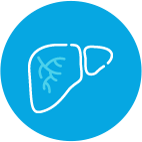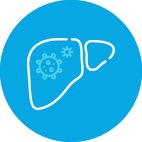Curogen provides optimized efficacy evaluation services to companies and organizations
based on our animal model developing technology and expertise in efficacy evaluation.
Psoriasis
Imiquimod (IMQ) & factor A-induced
psoriasis model
- · We apply a small amount of IMQ cream on the mouse’s back and administrate IP injection with factor A to deepen and maintain psoriasis.
- · Along with IMQ, a well-known factor, we additionally apply our factor A. The severity maintains longer by the combination than just applying IMQ, making the model more adequate for severe psoriasis.
IBD
Dextran sulfate sodium (DSS)-induced
inflammatory bowel disease (IBD) model
- · This model makes it easy to induce IBD with dextran sulfate sodium (DSS) with a high reproducibility rate.
- · DSS shows toxicity towards colon epithelial cells, causes functional damage in the membrane, and infiltrates inflammatory cells.
- · It shows weight loss, diarrhea, and blood in stool similar to those seen in ulcerative colitis of humans.
Dinitrobenzene sulfonic acid (DNBS)-induced
inflammatory bowel disease (IBD)
model
- · This model makes it easy to induce IBD with dinitrobenzene sulfonic acid (DNBS) with a high reproducibility rate.
- · Due to induced Th1 immune response, DNBS-induced IBD model exhibits immune responses that are similar to Crohn’s disease patients with increased TNFα and IL-12.
Nonalcoholic Steatohepatitis (NASH)
Western diet-induced NASH model
- · This NASH model can be induced with a high fat, high cholesterol, and high fructose diet.
- · This model shows noticeable steatosis, inflammation, and fibrosis. Hepatocyte ballooning can also be shown sometimes.
Choline deficient, amino acid defined (CDAA)
-High fat diet (HFD)-induced
NASH
model
- · This NASH model can be induced with a Choline-deficient, L-amino acid-defined, and high fat diet.
- · In this model, fibrosis stage 2 is induced. It noticeably exhibits steatosis, inflammation and fibrosis. Hepatocyte ballooning can also be shown sometimes.
CCL4-Choline deficient, L-amino acid defined
(CDA)-High fat diet
(HFD)-induced
NASH model
- · In this model, CCL4 is used to induce hepatoxicity and fibrosis along with a Choline-deficient, L-amino acid-defined, high fat diet.
- · Fibrosis at stage 3 and over is induced while noticeably exhibiting steatosis, inflammation, hepatocyte ballooning, and fibrosis.
- · This model exhibits severe NASH symptoms similar to humans. Before NASH develops into hepatocirrhosis, the inducement is terminated so that the model can be used for NASH.
Streptozotocin-High fat diet (HFD)
-induced NASH (STAM) model
- · Streptozotocin-induced neonatal mice are used for this model.
- · Fibrosis at stages 2 and 3 is induced while noticeably exhibiting steatosis, inflammation, hepatocyte ballooning, and fibrosis.
- · This model exhibits severe NASH symptoms similar to humans. Before NASH develops into HCC, the inducement is terminated so that the model can be used for NASH.
Methionine/choline deficient diet
(MCD)-induced NASH model
- · This NASH model can be induced with a methionine and choline deficient diet.
- · Steatosis, inflammation, and fibrosis are noticeably exhibited. Hepatocyte ballooning can be shown as well.
Hepatocellular Carcinoma (HCC)
Diethylnitrosamine (DEN)-induced HCC model
- · This hepatocellular carcinoma (HCC) model is induced with diethylnitrosamine (DEN) through IP injection.
- · DEN is injected into a 2-week-old mouse. After 9 or 10 months, HCC is induced. Male mice are used for this model because female mice show low incidence rates.
- · DEN injection induces DNA mutation and oxidation stress, leading to HCC development.
Oncogene-induced HCC model
- · This HCC model is induced with oncogenes.
- · When oncogenes are delivered through hydrodynamic injection directly to the liver via tail vein, HCC is induced after 6 to 8 weeks.
- · Nodular type tumors occur on the liver’s surface and diffuse type tumors occur around portal veins and blood vessels.
Syngeneic HCC model
- · This model induces cancer by oncogene homotransplantation.
- · After 2 to 6 weeks of injecting oncogenes into the liver or hypodermal HCC is induced.
- · When oncogenes are transplanted into the liver, it mimics tumor microenvironment.
Streptozocin (STZ)-induced HCC model
- · This HCC model is induced with streptozotocin in neonatal mice.
- · This model is accompanied with NASH.
Procedures
-
Consultation
Consult with us and be assigned with a personal coordinator
-
Order Review
Upon your evaluation request, we design your efficacy evaluation experiment layout
-
Technology Evaluation
After categorizing the service type, you will be assigned with an evaluation supervisor
-
Contract
Sign our service agreement contract
-
Efficacy Evaluation
We conduct the experiment, write lab reports, and analyze evaluation results
-
Results
Efficacy evaluation results will be sent to customers
- · Get personalized efficacy evaluations by contacting us.
- · Contact info: Curogen Efficacy Evaluation Center, +82-31-299-6232, curogencro@curogen.co.kr





